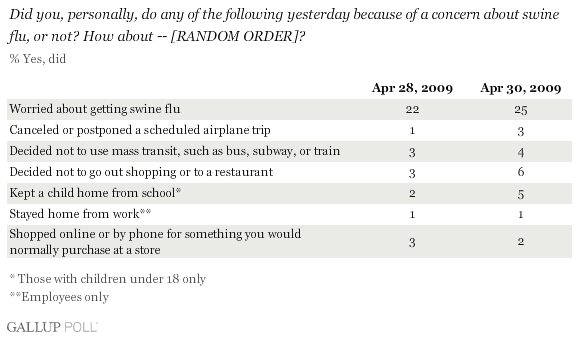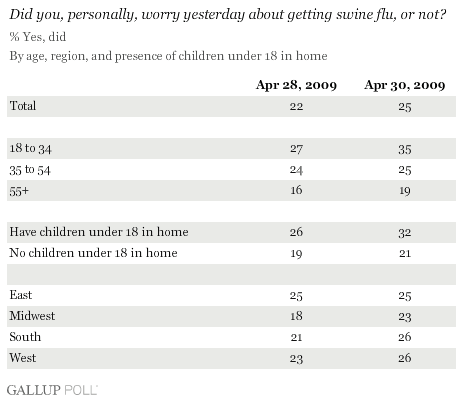PRINCETON, NJ -- One out of four adult Americans interviewed by Gallup Thursday said they worried about getting swine flu "yesterday," a slight increase over the 22% who said they worried in Gallup's initial poll on April 28. There have been similarly slight, but not statistically significant, increases in Gallup's tracking measures of the impact of the flu situation on behavior, including small rises in the percentage who have canceled or postponed shopping or eating out (from 3% to 6%) or airplane travel (from 1% to 3%). The percentage of parents who kept children home from school has moved from 2% on Tuesday to 5% on Thursday.

The latest Gallup Poll update on the impact of swine flu, or H1N1 virus, on the attitudes and behavior of the average American was conducted Thursday night, April 30. The percentage of those interviewed who reported that they personally worried about getting swine flu "yesterday" (25%) is up three points from Tuesday night's data. A change of this size is not statistically significant.
The lack of a major jump in worry is notable given the increased news coverage of the swine flu situation over the last several days, including publicity about the death of at least one person in the United States, the World Health Organization's labeling of the situation as an imminent pandemic, the closing of schools across the country -- including the entire Fort Worth, Texas, public school system -- and reports that Mexico is virtually shutting down as a result of the flu.
Perhaps reflecting the news coverage of swine flu outbreaks in schools, the trends show slightly larger growth in concern among Americans aged 18 to 34 and among those with children in the home than among other groups. The increase in worry was also slightly larger in the Midwest and South than on either the East or West coasts.

Gallup's tracking of the impact of the flu situation on reported behavior shows results that are in a general sense similar to the impact on overall worry. The slight increases in self-reported behavioral changes that have occurred are not statistically significant.
-
The percentage of Americans who say they have decided not to go shopping or out to a restaurant because of concern about swine flu is up from 3% to 6% -- not a statistically significant change, but a movement in the direction that, if continued, could begin to have an effect on consumer spending.
-
Despite widespread news coverage of Vice President Biden's comment that Americans should avoid mass transit, there has been only a one-point increase in the percentage who in fact say they decided not to take a trip on mass transit.
-
There was a two-point increase in the percentage of Americans who canceled an airplane trip, but the percentage is still very low, at 3%.
-
The percentage of Americans with children under 18 at home who report having kept at least one of those children home from school has moved from 2% to 5%.
-
There was no increase in working Americans' reports that they stayed home from work (1% both Tuesday and Thursday), and a decrease of one point in the percentage who say they shopped online or by phone as a result of concerns about swine flu.
As noted, none of the changes in these reports over the last two days is statistically significant. Still, if these trends continue, the impact of the flu will almost certainly begin to be felt in America's retail sector, something that is not an optimal occurrence given the currently parlous economic times.
Gallup will continue to update the estimates of changes in these behaviors in the coming days.
Survey Methods
Results are based on telephone interviews with 1,010 national adults, aged 18 and older, conducted April 30, 2009. For results based on the total sample of national adults, one can say with 95% confidence that the maximum margin of sampling error is ±3 percentage points.
Trend results are based on telephone interviews with 1,021 national adults, aged 18 and older, conducted April 28, 2009. For results based on the total sample of national adults, one can say with 95% confidence that the maximum margin of sampling error is ±3 percentage points.
Interviews are conducted with respondents on land-line telephones (for respondents with a land-line telephone) and cellular phones (for respondents who are cell-phone only).
In addition to sampling error, question wording and practical difficulties in conducting surveys can introduce error or bias into the findings of public opinion polls.
Polls conducted entirely in one day, such as this one, are subject to additional error or bias not found in polls conducted over several days.
